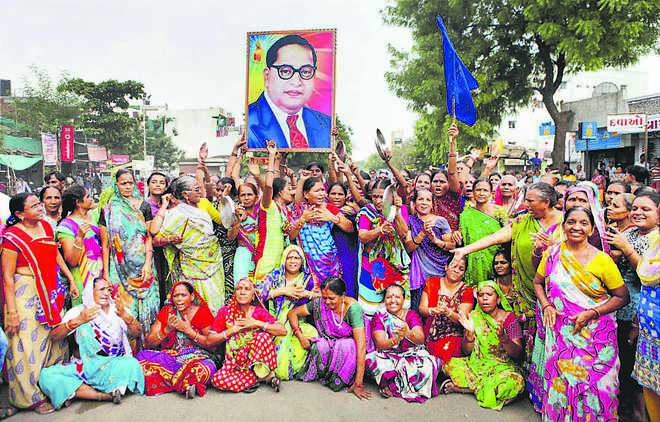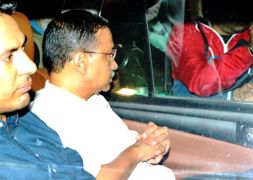
Dalit women with BR Ambedkar’s portrait block traffic as they protest in Ahmedabad. Assault on Dalits by gau rakshaks evoked anger.
Ravichandran Bathran
With the present government under the rule of Prime Minister Narendra Modi, however, caste Hindus are adopting the tactic of organising violence under the garb of militant organisations affiliated to Hindutva that are close to the ruling BJP. It is for the first time that ruling party members are openly advocating violence. For example, a BJP member, Rajasingh, took to Facebook to support the violence perpetrated on Dalits in Gujarat. Violence is perpetrated on anyone who opposes or differs from the government's political views. In this context, it is important to take a relook at the recent Una violence and the subsequent Dalit protests.
For the first time, Narendra Modi condemned the gau rakshaks who had attacked the seven Dalits in Gujarat. The Dalits saw this as an act of caste Hindu violence. However, many including the Opposition reduced the root of the violence to certain rabble-rousing gau rakshaks, the state BJP, and the central government. The condemnation failed to persuade the protesters in Gujarat or members of the Rohith Vemula movement. The Prime Mintser's reaction, however, is not unique to this protest. In the past too, he has engaged with the Dalit question. On Rohith Vemula's suicide, he said: “Mother India has lost a son” and “he felt the pain”. Although he took a broom and cleaned the streets for the Swachh Bharat campaign as part of the cleanliness drive, nothing has changed on the ground. One gets the nagging feeling that all of these gestures are aimed at the media.
In the past, Modi has eulogised Dalits and their sufferings and once he also described manual scavenging as a “spiritual experience”. Even as he makes emotional appeals to the masses, on the ground gau rakshaks engage in violence and murder. It is the involvement of a BJP minister in the students' affairs of the University of Hyderabad that led to Rohith Vemula's suicide. Apart from emotional appeals, neither the Prime Minister nor his party have shown any regret. Modi's emotional appeal is not unique to the BJP. In the past, Rahul Gandhi, the Vice-President of the Congress party too has reached out to Dalits in Uttar Pradesh many times. Even before this, Mahatma Gandhi himself stayed in a Balmiki colony to persuade Dalits that there was no discrimination. He took to cleaning his own toilet. It only shows that concerns were expressed and appeals were made only to avoid implementing the law, leaving the core issue intact. The recurring trend of approaching the caste issue through symbolic gestures and without implementing the rule of law, continues even now. As a result, most of the appeals are directed towards the victim and the accused is protected. Most political parties in India have been addressing caste violence through similar symbolic gestures.
It is this politics that led to the “reservation”of a few seats for SCs and the lack of attention to the violence faced by Dalits on a day-to-day basis. It is precisely due to this that Babasaheb Ambedkar had argued for a social revolution even before we got Independence.
The Una violence and various other atrocities perpetrated on Dalits in recent times need special attention, and in this context, we need to look at spaces provided by the Internet as well. Internet spaces are imagined as enclaves shielded from caste discrimination. Incidents such as those in Una, where Dalits were dragged from their village to a town, tied to a vehicle in front of a police station, video recorded, and their videos uploaded online force one to rethink about these spaces. Such violence on Dalits is usually situated within villages where they are variously subjected to violence, including being dragged to a public place, tied, burnt, lynched, harassed, and raped only to threaten and send a warning to Dalits who want to move away from caste subjugation.
In most such cases, the police offers covert support to the culprit. The recent video is intended as a message of threat to Dalits — to those who are present in social media and actively participate in discussions against the caste system but imagine that cities and universities are secluded from caste discrimination and violence. There is a consistent pattern to the images and videos of Dalit bodies that are being circulated.
We hear and read about caste organisations such as those of the Patels of Gujarat and the Jats in Haryana protesting for reservation and bringing the city to a standstill while breaking public properties and harassing the public — this makes one realise that caste organisations are increasingly becoming more violent. We also regularly see pictures of Dalit bodies which are being stripped, beaten, fed cow dung, and hung after being raped being circulated online without any scrutiny. Even television channels circulate these pictures without much introspection. We, however, do not hear of any interventions made by the police or any state agencies as a result of this circulation. With this background in mind, one has to think what impression such pictures can make on Dalit men/women.
The video of Una shocked me and made by body tremble, and I was forced to ask if we were living in a country which respects the rule of law. At least, in this instance, Dalits came out in protest and dumped dead cows in front of the bureaucratic offices, declaring that they will not remove the carcasses. But all incidents are not met with the same kind of response.
Different techniques are used to police different communities in India. If Dalits are physically controlled through mob violence, adivasis are termed supporters of Maoists and Muslims are connected to terrorism. If earlier Dalits used to mobilise and organise rallies, talks, and discussions, in recent times they have been increasingly adopting new methods to express their protests. In 2012, Osmania University Dalit-Bahujan students organised a beef festival. This created fierce public debates about the undemocratic food practices in India, especially in university hostels. They argued that if a student runs the daily affairs of a mess then the choice of food should be with the students' collective rather than on some religious sanctions. Also, in 2010, Dalits in Savanur, Karnataka, smeared human excreta on themselves and protested against their forceful evacuation by the municipality.
If in the 1980s and 1990s, Babasaheb Ambedkar's statues showed him holding a Constitution in his hands, it was also the period during which Dalits mobilised and rallied against the state and the judiciary. In recent times, there is a tendency to depict Babasaheb without the Constitution and there is a likelihood that the present imagination of Ambedkarites is likewise depeleted.
The writer is a Fellow at the Indian Institute of Advanced Study, Shimla.
There has been a rise of crimes against Dalits
According to National Crimes Records Bureau, crimes against Dalits rose almost steadily from 2009 to 2014:
2014 47,064
2013 39,408
2012 33,655
2011 33719
2010 32,712
2009 33,594
Rapes of Dalit women
2014 2,233
2013 2,073
2012 1,576
2011 1557
2010 1349
2009 1346
Kidnappings and
abductions too went up, barring in 2012 which saw a marginal decline.
2014 755
2013 628
2012 490
2011 616
2010 511
2009 512



























